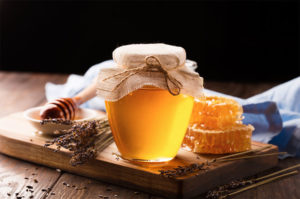 If you’re like me, you put honey in your tea or on your cornbread—but what about putting it on your loved one’s cuts and scrapes? At first, this idea might seem sticky and strange, but it turns out that honey has been used to heal wounds for thousands of years. Unlike other “alternative” health products on the market, which make empty therapeutic claims, there’s a growing body of scientific evidence that supports the healing powers of honey.
If you’re like me, you put honey in your tea or on your cornbread—but what about putting it on your loved one’s cuts and scrapes? At first, this idea might seem sticky and strange, but it turns out that honey has been used to heal wounds for thousands of years. Unlike other “alternative” health products on the market, which make empty therapeutic claims, there’s a growing body of scientific evidence that supports the healing powers of honey.
When you go to the grocery store, you’ve probably noticed the many different types of honey on the shelves. Honey comes in lots of varieties depending on the nectar source, the species of bee, and other conditions. Scientific testing by many laboratories has revealed that one of those, Manuka honey, which is a specific type of honey made by bees native to New Zealand and Australia has multiple benefits, including antimicrobial activity, unique potency, and promoting the wound healing process.
Manuka honey has a knack for fighting a wide range of disease-causing bacteria. It’s acidic and contains a lot of sugar, making it a harsh place for bacteria to live, even causing them to explode. Manuka honey has other secret weapons too, like hydrogen peroxide that attacks bacteria with free radicals and methylglyoxal (MGO) that bombards the building blocks of the bacterial cell. MGO can also kill bacteria that hide in bacterial masses called biofilms. Biofilms form in wounds, and they are notoriously difficult to treat using many traditional antibiotics. The anti-biofilm activity of Manuka honey gives it an extra wound protective edge.
These antimicrobial abilities give Manuka honey a unique potency not seen in many other products. Manuka honey has been used to successfully to treat some of the worst clinical pathogens, and it can be applied in combination with antibacterial drugs to enhance their antimicrobial effects, even blocking bacterial resistance from developing. In a time when many antibiotics are becoming increasingly useless in the face of bacterial resistance, Manuka honey’s unique potency allows it to remain a stable treatment option into the future.
In addition to protecting against bacteria like Escherichia coli (E. coli) and Methicillin-Resistant Staphylococcus aureus (MRSA), Manuka honey also promotes the natural wound healing process. It contains several types of antioxidants and anti-inflammatory agents that are particularly helpful in treating irritated skin, burns and wounds. It’s not surprising that the healing properties of Manuka honey is expanding into to new applications—Manuka honey is even being added to cosmetics to slow wrinkle formation.
Despite its long history as a healing product, Manuka honey has only recently caught the attention of scientists and clinicians. Research continues to uncover promising therapeutic properties and applications of Manuka honey and will inform and advance its use into the future.
References:
- Maddocks S, Jenkins R, Rowlands R, Purdy K and Cooper R. Manuka honey inhibits adhesion and invasion of medically important wound bacteria in vitro. Future Microbiol. 8(12):1523-36 https://www.ncbi.nlm.nih.gov/pubmed/?term=Manuka+honey+inhibits+adhesion+and+invasion+of+medically+important+wound+bacteria+in+vitro
- Carter D, Blair S, Cokcetin N, Bouzo D, Brooks P, Schothauer R and Harry E. Therapeutic Manuka Honey: No Longer So Alternative. Front. Microbiol. 20;7:569 https://www.ncbi.nlm.nih.gov/pubmed/?term=Therapeutic+Manuka+Honey%3A+No+Longer+So+Alternative
- Burlando B and Cornara L. Honey in dermatology and skin care: a review. J Cosmet Dermatol. 12(4):306-13 https://www.ncbi.nlm.nih.gov/pubmed/24305429
- Molan P and Rhodes T. Honey: A Biologic Wound Dressing. Wounds. 27(6):141-51 https://www.ncbi.nlm.nih.gov/pubmed/26061489
